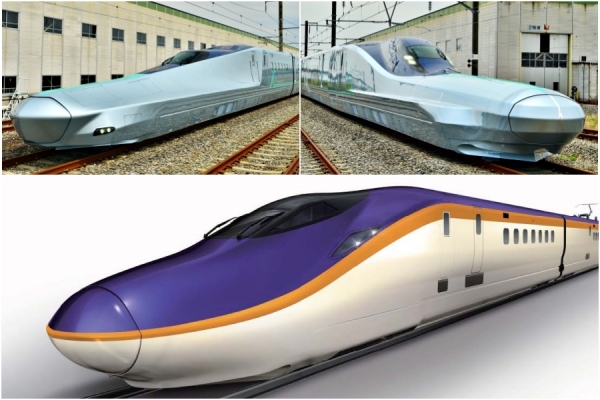JR News: 2 Next-generation shinkansen trains to look forward to

After shinkansen tracks have been built and are operational, what else can be done to improve the experience? The answer lies in the trains. Shinkansen train technology is constantly upgrading, so let us take a look at two of JR East’s next-generation train vehicles: ALFA-X and the E8 series.
ALFA-X (Tohoku Shinkansen)
The E956 series train is an experimental shinkansen train affectionately known as ALFA-X, an acronym for Advanced Labs for Frontline Activity in rail eXperimentation. It is a prototype for developing next-generation shinkansen vehicles that will be used on the Tohoku Shinkansen and Hokkaido Shinkansen extension to Sapporo, which is estimated to open in 2030.

ALFA-X train. (Image credit: JR East)
From May 2019 to March 2022, test runs are being conducted mainly between Sendai Station and Shin-Aomori Station on the Tohoku Shinkansen. These test runs are conducted about twice a week at night, when regular passenger trains are not operating.
In addition to improving the environmental performance of the next-generation shinkansen vehicles, long-term running tests are also carried out to check the development of safety improvements, including earthquake countermeasures. For vehicle performance tests, speeds of 400km/h have been achieved. However, when carrying passengers, it is estimated that the maximum operating speed will be 360km/h.
Car 1 of the ALFA-X. (Image credit: JR East)
The ALFA-X has two differently-shaped noses on its two ends. The nose of Car 1, which faces the direction of Tokyo, is 16m long, similar to the nose length of the current E5 series trains that run on the Tohoku Shinkansen.
Car 10 of the ALFA-X. (Image credit: JR East)
The nose of Car 10, which faces the direction of Shin-Aomori, is 22m long, the longest ever for a shinkansen train. Long noses help to “break” the pressure when entering tunnels at high speeds, so that passengers can travel comfortably with less discomfort in their ears.
The ALFA-X has dampers that suppress both left-right motions and up-down vibrations to improve the riding experience. The underside of the train also has a special design to reduce the build-up of ice and snow, as Tohoku and Hokkaido are known for their bitterly cold and snowy winters.
It may be years before the next-generation shinkansen go into operation, but the ALFA-X gives us a glimpse of what they can be capable of!
E8 series (Yamagata Shinkansen)
In 2020, JR East announced that they would be building a new E8 series rolling stock for the Yamagata Shinkansen, and starting the construction of the Fukushima Station approach line.
It is planned that 17 seven-car E8 series train vehicles will be built from September 2022 onwards, gradually replacing the E3 series trains and entering service on the Yamagata Shinkansen from spring 2024 until spring 2026. In addition, JR East aims to operate the trains at 300km/h between Utsunomiya Station and Fukushima Station on the Tohoku Shinkansen, coupled with E5 series trains.

Artist's impression of the exterior of the E8 series train. (Image credit: JR East)
The new E8 series trains will feature a 9m-long nose, which is 1.5 times longer than the 6m-long nose of the E3 series trains. The new trains will also feature luggage racks suitable for large luggage in all its seven cars.
The colours of the trains body are “Zao white” for the snow of the Zao Mountains, “safflower yellow” for the safflower, Yamagata’s prefectural flower, and “Mandarin duck purple” for the Mandarin duck, Yamagata’s prefectural bird.

Artist's impression of the interior of the Green Car. (Image credit: JR East)
Inside, the Green Car carriage is designed with images of the Mogami River (Yamagata’s most important river) and Mount Gassan (Yamagata’s representative mountain) in mind. The central passage is designed with the flowing Mogami River as a motif, while the seat fabrics are a deep green colour to represent Mount Gassan’s rich forests.

Artist's impression of the interior of the Ordinary Car. (Image credit: JR East)
The Ordinary Car carriages are designed with the image of safflowers, Yamagata’s prefectural flower. The seat fabrics are a gradation of the dark yellow of safflower flowers to the dark red of safflower dye, and represent safflower dye extraction, an important industry in Yamagata.
It may still be a while before these trains go into operation, but I am sure that many of us are looking forward to riding them.
Header image credit: JR East





